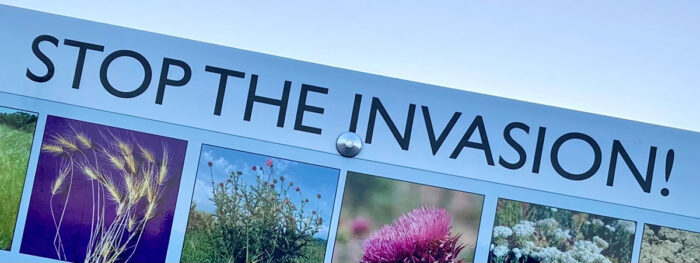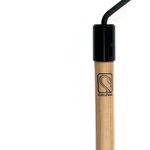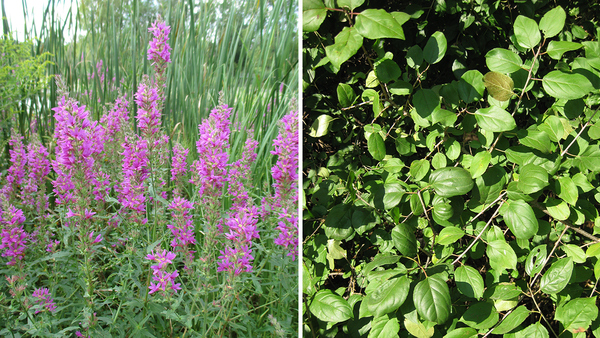
Invasive plants are nonnative introductions that have the ability to germinate, establish, thrive, reproduce, and spread to other areas without any help from humans. They’re the tough, rugged trespassers that take over natural wetlands, wildlands, rangelands, and pastures. They compete (and frequently win) against native plants in the battle for resources such as light, water, and nutrients. Invasive plants can cause trouble in a myriad of ways. They can affect soil fertility or smother the soil, blocking the germination and growth of native species, thus disrupting natural ecosystems by crowding out natural forage (e.g., nectar, foliage, seeds) for the indigenous insect population. This of course affects their numbers and diversity, which in turn impacts the birds, amphibians, mammals, and reptiles who depend upon them. Economically, invasive plants can hurt crop production and cause significant damage to rangeland and pastures, occasionally even poisoning the unfortunate cow that might find itself chewing on the wrong plant.
Invasive plants are usually free of natural pests, making them far more problematic than your typical, easily-removed weed, with the severity of the impact dependent upon the plant species itself and the particular area it’s invading.
Many NorCal invasives were originally imported for a purpose
Invasive plants often arrived innocently but took hold in California’s benign climate. For example, the lofty, white-flowering Tasmanian blue gum (Eucalyptus globulus, Zones 9–11) was introduced to California during the Gold Rush to quickly provide shade and shelter, firewood, and windbreaks. Tough, drought tolerant, and pest resistant, this now widespread aromatic giant drops so many of its thick, leathery leaves that the accumulated essential oil-infused leaf litter suppresses all possibilities of the growth and survival of more-desirable plant species.
The seeds of one of NorCal’s most invasive plants—the yellow starthistle (Centaurea solstitialis, annual)—accidentally arrived in imported animal fodder, and it has caused enormous changes to the nature of pastures and rangelands all across the region. It has reduced animal forage quantity and quality, and has punctured many a bicycle tire and shoe sole at the same time.

Highway iceplant (Carpobrotus edulis, Zones 7–10), which is also known as hottentot fig, was introduced in the 1960s for erosion control and for its attractive blooms. Its rugged drought resistance allows it to spread easily both by seeds and vegetatively. Basically this plant can thrive everywhere, including highway medians, grasslands, coastal scrubland, sand dunes, and beaches. This low-growing succulent creates tight, dense foliage mats that result in increased soil organic matter, which ultimately allows nonnative species to take root and crowd out indigenous plants. It is extremely difficult to control.
Other invasive plants can be traced back to the nursery trade
Unfortunately, many of the qualities that make a plant a successful landscape ornamental are the exact qualities that can lead to invasiveness in a natural setting. To its collective embarrassment, the horticulture industry has released many plants that began as low-maintenance, easy-to-grow, fast-spreading, floriferous beauties but that have subsequently become invasive pests. Of the species listed on the California Invasive Plant Council Inventory, over 45% were introduced as ornamentals. This list includes:
- Myoporum (Myoporum laetum, Zones 9–11)
- Periwinkle (Vinca major, Zones 4–9)
- Pampas grass (Cortaderia selloana, Zones 8–10)
- Green fountain grass (Pennisetum setaceum, Zones 8–11)
- Portuguese broom (Cytisus striatus, Zones 6–10)
- Giant reed (Arundo donax, Zones 6–10)

Though the above-listed nuisances are seldom found in California nurseries these days, almost any plant can be brought in from elsewhere via internet or print catalogs, so be sure to shop locally whenever possible and to educate yourself about the nature of any plant before considering bringing it in from out of state. Be cautious of plants that thrive without a gardener’s help! Know what is invasive in your particular area, and avoid it.
A plant that is invasive in one region may not be considered invasive in another
Don’t panic if any of the plants in this article are already growing in your garden. Each plant’s invasive potential can be quite specific to each region. In fact, a small number of California natives have been known to cause problems if grown outside of their specific natural environment. Plants currently still available in garden centers but are on the watch list for potential invasiveness in certain parts of Northern California include:
- Santa Barbara daisy (Erigeron karvinskianus, Zones 6–9)
- Calla lily (Zantedeschia aethiopica, Zones 8–10)
- Mexican feather grass (Stipa tenuissima, Zones 7–11)
- Fennel (Foeniculum vulgare, Zones 4–9)
- Algerian ivy (Hedera canariensis, Zones 7–9)
- English ivy (Hedera helix, Zones 4–9)
- Butterfly bush (Buddleia davidii, Zones 5–9)
- Silver wattle (Acacea dealbata, Zones 9–11)
 |
 |
 |
 |
Again, knowledge is crucial. There are a number of helpful resources if you’d like to learn more, starting with the UC Agriculture and Natural Resources website and The Center for Invasive Species and Ecosystem Health website. Your local garden center or nursery should also be able to direct you to plants currently known to be safe for your area.
—Fionuala Campion is the owner and manager of Cottage Gardens of Petaluma in Petaluma, California.
Photos: Fionuala Campion
Fine Gardening Recommended Products

ARS Telescoping Long Reach Pruner
Fine Gardening receives a commission for items purchased through links on this site, including Amazon Associates and other affiliate advertising programs.

Pruning Simplified: A Step-by-Step Guide to 50 Popular Trees and Shrubs
Fine Gardening receives a commission for items purchased through links on this site, including Amazon Associates and other affiliate advertising programs.

CobraHead® Long Handle Weeder & Cultivator Garden Tool
Fine Gardening receives a commission for items purchased through links on this site, including Amazon Associates and other affiliate advertising programs.


















Comments
Log in or create an account to post a comment.
Sign up Log in